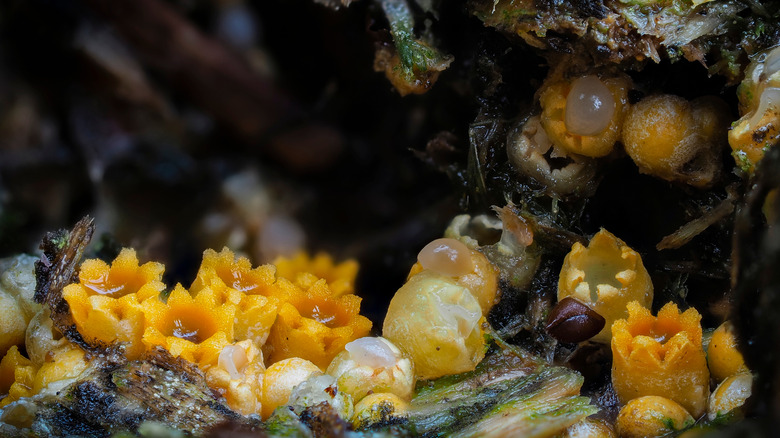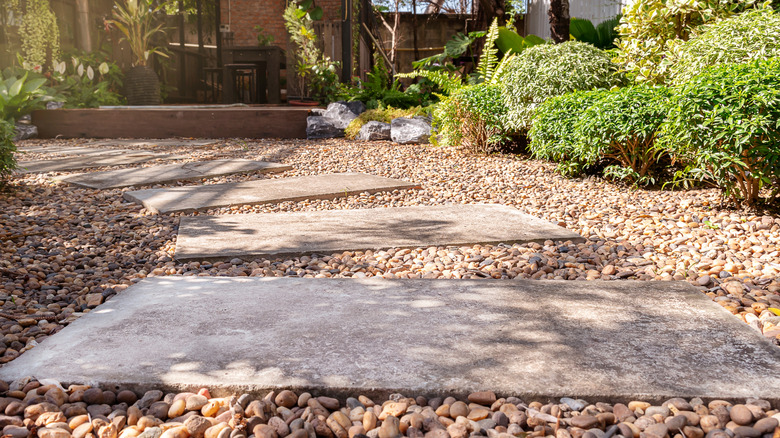Those Strange Black Dots On Your Windows Are Actually A Fungus. Here's What To Do About It
We may receive a commission on purchases made from links.
If you see strange black dots on your window, it might surprise you to learn that they're not, in fact, tiny annoying bugs, but a fungus. Specifically, they're the spores of Sphaerobolus stellatus, also known as artillery fungus. These little spots may seem harmless and you may think you can just blast them from your windows with a hose, but their removal can be tricky. Thanks to the sticky substances it contains, artillery fungus can linger on your window after they dry. Pressure washing alone will often not cause them to budge and there are no known fungicides that can tackle it. So, what can you do about it? Unfortunately, the most effective removal of artillery fungus is by hand. You'll need soap and water, plus a reliable window scraper or razor blade.
Artillery fungus can grow in hardwood mulch, producing and releasing airborne spores it forcefully sends up to 15 feet high and 20 feet wide. Those bothersome little black spots are actually called peridioles, small packets of spores, and they can be viable for up to 10 years, quickly spreading to other locations. Due to the spots looking like the aftermath of a spray of bullets, it's sometimes referred to as shotgun fungus. The fungus operates by aiming its spores towards light, such as the sun, but also reflective surfaces. Its projectiles may land on your window, creating those annoying spots all over the surface, as well as hitting your siding, car, and gutters. While it's not dangerous to humans or pets, artillery fungus is unsightly. It's important to remove it upon spotting it, because the longer it lingers, the more difficult its removal.
How to clean artillery fungus off your home's windows
The spores of artillery fungus are notoriously stubborn and hard to remove, which is why once you spot it, you should jump into action. First, mix up a solution of soap and water in a spray bottle, then spray your windows thoroughly. Wetting your windows will help loosen the spores and make it easier to scrape them off without damaging the windows. Once you have the surface sufficiently wet, you can use a razor blade or scraper (try Unger Professional 4-inch All-Purpose Scraper), to remove. As you work, keep the surface continually wet to reduce scraping the glass, and always hold the razor at a 45 degree angle. Be patient, as this isn't a job that you can do in a few minutes. It takes time, elbow grease, and light pressure. Rinse with clean water when done.
If encountering a particularly sticky spore, try wetting it directly with a soapy sponge or cloth, then scraping. Some window cleaning experts recommend using equal parts vinegar and water for the tough spots, letting it sit on the spores to penetrate it. Vinegar is a secret to dazzling clean windows, and it can help remove the fungus easier. After it sits on the spores for a few minutes, wipe away with a soft, clean cloth. Before using anything abrasive on your windows, check your manufacturer's information to ensure it's safe to use.
Preventing artillery fungus from coming back
Once you've tackled the fungus on your windows, focus on prevention so it doesn't reoccur. There's no proven way to keep the fungus from coming back entirely, especially if it originates from your neighbor's lawn. You can, though, take a few landscaping steps for managing this fungal growth. Look carefully at the elements in your yard that may be feeding your fungus, namely dead and decaying wood. Try to reduce sources of moisture and increase air flow through the mulch by raking and removing any accumulated debris.
If you must use mulch in your yard or garden, experts at the Connecticut State Agricultural Experiment Station recommend using mulch with a minimum of 85% bark, such as pine bark nuggets. Wood chips, especially, offer a reliable source of food for artillery fungus because of the wood chips' rich supply of carbon. You may also want to substitute other things for mulch, using rock, marble, gravel, or stone in its place to create a less hospitable environment. While not proven yet by conclusive studies, a good approach can be to reapply your mulch annually to inhibit its growth. Application of used mushroom compost can also be effective. Penn State University suggests blending it with a landscape mulch at about 40% to greatly suppress the sporulation, or spore formation. Lastly, using a ground cover instead of mulch may be an effective choice because it gets rid of the decaying matter. When removing your mulch, throw it away in a biodegradable bag in the landfill so it doesn't become the problem of others on your block.


